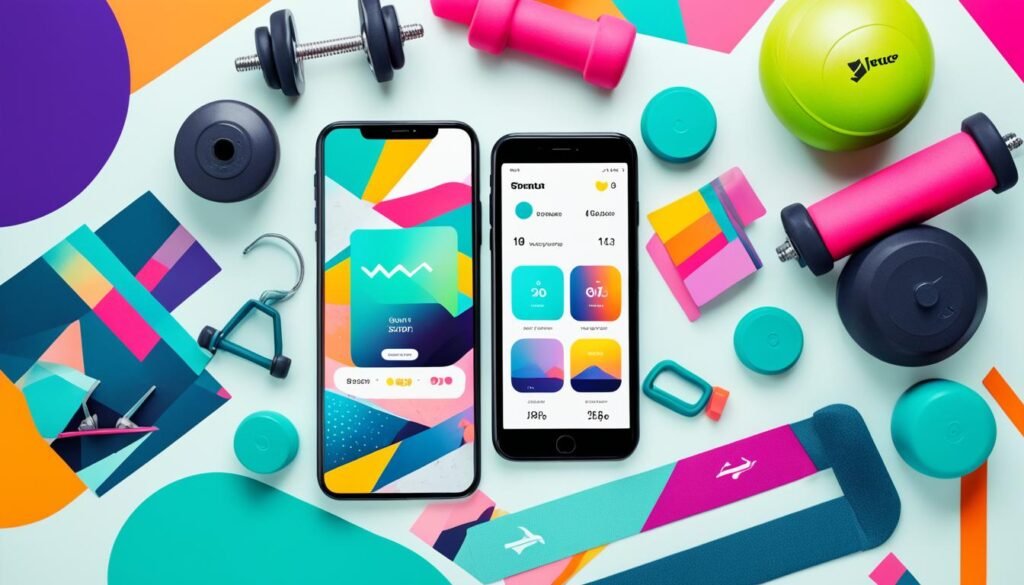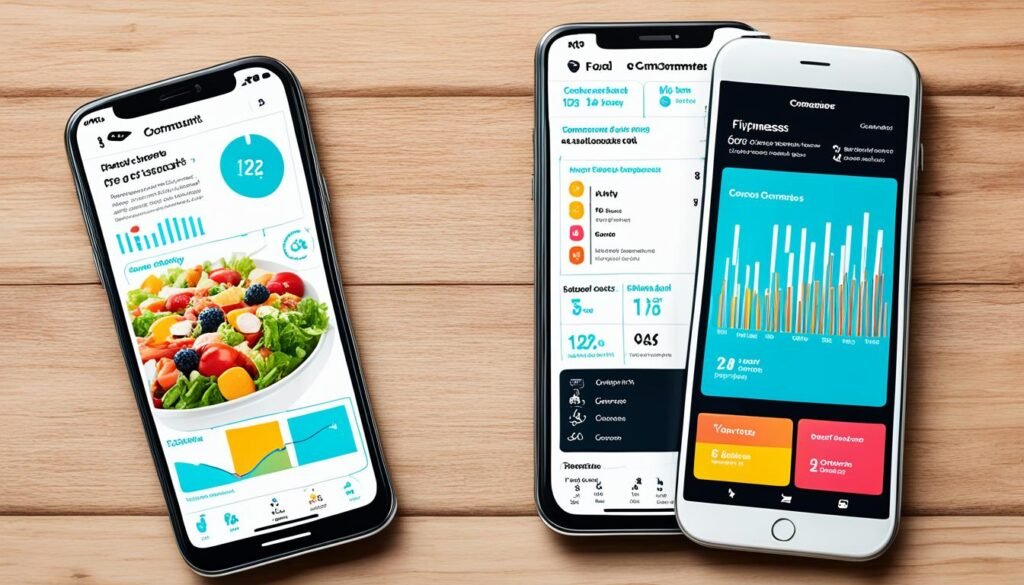We independently test and review fitness products using a research-based approach. If you buy through our links, we may earn a small commission at no extra cost to you. Read our Disclosure
Navigating the world of health and nutrition apps can feel like a daunting task, especially when trying to choose the one that fits perfectly with your wellness goals. Two of the most popular contenders on the market are Cronometer and MyFitnessPal.
Both apps claim to offer the most comprehensive nutritional data and user-friendly experience, but which of them truly delivers? Each has its unique strengths, appealing to different types of users based on their individual needs and preferences.
In this post, we’ll explore the features, functionalities, and usability of both Cronometer and MyFitnessPal to help you decide which app can most effectively support your journey towards a healthier lifestyle. Get ready to discover the ins and outs of these nutritional powerhouses!
Introduction to Cronometer and MyFitnessPal
Cronometer and MyFitnessPal are standout apps in the nutrition tracking space, each bringing something unique to the table for health enthusiasts.
Cronometer is renowned for its precision. It provides users with in-depth insights into their micronutrient intake and boasts a comprehensive food database verified by experts. Ideal for those who enjoy diving into granular details, it’s perfect for anyone seeking a deeper understanding of their nutritional profile.
On the other hand, MyFitnessPal shines with its extensive database and user-friendly interface. It supports a vast community of users who benefit from quick food tracking and an intuitive design. Known for its convenience and ease of use, it’s a favorite among newcomers to fitness tracking or those who prefer a more social approach to achieving their health goals.
Both apps serve diverse audiences, making them compelling choices for those ready to enhance their health journeys. Whether you’re a data-driven individual or someone looking for simplicity and community, there’s a lot to explore!
Differences in Features and Functionality
When it comes to features, Cronometer and MyFitnessPal cater to users with distinct needs. Let’s explore how they differ.
Cronometer is designed with an emphasis on accuracy and detail. It offers minute tracking of nutrients such as vitamins and minerals, making it valuable for those with specific dietary needs or health conditions. Its barcode scanner and custom food options enhance the precision of your entries, and with a focus on data integrity, Cronometer ensures highly accurate nutritional information.
MyFitnessPal, meanwhile, prioritizes user accessibility and community engagement. With its enormous food database and quick logging capability, it simplifies tracking for busy individuals. It also encourages social interaction by allowing users to share progress and support each other through fitness forums. This community aspect often motivates users to stay committed to their health journeys.
Both apps feature integrations with various fitness devices and apps, although MyFitnessPal supports a wider range for those invested in connected fitness ecosystems. Whether you value detailed nutritional data or a more community-driven approach, understanding these differences can help you find the right fit for your lifestyle.
User Interface Comparison
The user interface plays a crucial role in how you interact with any app, and both Cronometer and MyFitnessPal take distinctive approaches to their designs.
Cronometer is all about depth and precision. Its clean layout emphasizes detailed nutritional data, organized in an easy-to-navigate manner. Although it might appear more data-rich at first glance, users who enjoy detailed analytics will appreciate the structured presentation of complex information.
Conversely, MyFitnessPal offers simplicity and speed. Its intuitive design caters to users who prefer quick access to core features like food logging and exercise tracking. The app’s straightforward navigation and bright, engaging design invite casual exploration, making it an accessible choice for beginners or those who prioritize ease of use.
Ultimately, the choice between Cronometer’s comprehensive approach and MyFitnessPal’s quick and easy style depends on personal preference. If you want to delve deeply into your nutritional analysis, Cronometer might appeal to you. If you prefer a more straightforward and social tracking experience, MyFitnessPal might be the way to go.

Pricing and Subscription Options
Understanding the costs and benefits of each app’s pricing model is key to choosing the right one for you.
Cronometer offers a free version packed with essential features, but for those seeking enhanced analysis, the Gold subscription is available. It provides advanced metrics, priority support, and other exclusive features, making it a worthwhile investment for detailed tracking enthusiasts.
MyFitnessPal, too, has a robust free version that’s more than sufficient for basic tracking. However, its premium subscription unveils a suite of advanced features like custom calorie goals and detailed nutrition insights. This upgrade is tailored for individuals looking to take their fitness journey to the next level through personalization.
Making the Cost Count
Both apps offer subscription plans that are billed monthly or annually, with discounts often available for annual payments. This flexibility allows users to choose the best fit based on their usage and commitment levels.
Ultimately, deciding between the free and premium versions of Cronometer and MyFitnessPal depends on how detailed you want your tracking to be. Consider your goals and how much you’re willing to invest in your health journey when making your choice.
Data Accuracy and Database Comparison
Accurate data is essential for precise nutritional tracking, and both Cronometer and MyFitnessPal offer strong options, albeit with some differences.
Cronometer is particularly lauded for its emphasis on data accuracy. The app relies on verified food sources and databases, ensuring users can trust the precision of nutrient information. This focus makes it especially suitable for those with specific dietary needs or health conditions requiring close nutritional monitoring.
MyFitnessPal, in comparison, boasts one of the largest food databases available. While this means a broader selection of food items, the user-submitted data can occasionally lead to discrepancies. However, the community validation process helps improve accuracy over time, making it a reliable choice for most users.
Choosing the Right Database for You
Consider how you use nutritional data. If accurate tracking of micronutrients is crucial, Cronometer’s verified database could be more beneficial. On the other hand, MyFitnessPal’s expansive database caters to those who prioritize variety and convenience in logging their meals.
Ultimately, the choice between these apps may come down to whether you value a meticulously verified database or the flexibility and wide range offered by a larger, crowd-sourced one.
Community Support and User Engagement
When it comes to staying motivated, community support and engagement can make all the difference in your health journey. Let’s explore how Cronometer and MyFitnessPal foster these aspects.
MyFitnessPal excels in creating a vibrant and supportive community environment. Users can participate in forums, join groups with shared goals, and even connect with friends for added accountability. This sense of community not only provides encouragement but also makes the goal-setting process more enjoyable.
Cronometer, while offering forums and support for its users, is more focused on providing expert-driven insights rather than community engagement. It’s a great option for those who prefer a quieter, more analytical approach to tracking health goals without the added social features.
Finding Your Motivation
For those who thrive on social interaction, MyFitnessPal’s community engagement features might be particularly motivating. The ability to share progress and seek advice from fellow users can be a powerful tool in achieving long-term success.
Whether you’re looking for a community to cheer you on or prefer a more solitary focus on your dietary data, both apps provide options to support your personal journey. Consider how much community interaction influences your motivation when deciding which is a better fit for you.
Which One Should You Choose? The Bottom Line
Choosing between Cronometer and MyFitnessPal boils down to your specific health goals and personal preferences. Both apps offer invaluable tools for tracking nutrition and fitness, but they cater to different user needs.
If you’re someone who values detailed nutritional information and data precision, Cronometer might be your ideal companion. Its expert-verified database and focus on micronutrient tracking make it a favorite among those with specific dietary requirements or anyone looking to fine-tune their diet.
Alternatively, if ease of use and community support are paramount to your health journey, MyFitnessPal could be the better option. With its expansive food database and a strong emphasis on social interactions, it’s perfect for individuals seeking convenience and motivation through community engagement.
Pricing can also influence your decision. Both apps offer free versions, but their premium features cater to different needs. Consider what aspects are most important to your fitness goals when weighing the cost of upgrading.
In the end, your choice should align with what keeps you motivated and engaged. Whether you lean towards the analytical depth of Cronometer or the vibrant community of MyFitnessPal, both apps can guide you on the path to a healthier lifestyle.
Explore each option to see which resonates with you. Often, personal trial and error can be the best guide. Choose the one that fits seamlessly into your routine and makes your health journey an exciting and rewarding adventure.



